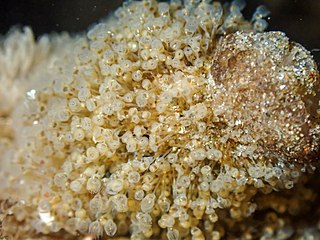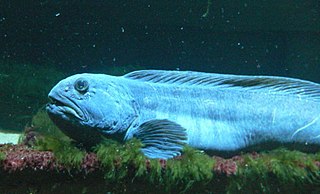| Bursovaginoidea | |
|---|---|
| Scientific classification | |
| Domain: | Eukaryota |
| Kingdom: | Animalia |
| Phylum: | Gnathostomulida |
| Order: | Bursovaginoidea |
| Suborders | |
Also see text | |
Bursovaginoidea is one of the two orders in the phylum Gnathostomulida. [1]
| Bursovaginoidea | |
|---|---|
| Scientific classification | |
| Domain: | Eukaryota |
| Kingdom: | Animalia |
| Phylum: | Gnathostomulida |
| Order: | Bursovaginoidea |
| Suborders | |
Also see text | |
Bursovaginoidea is one of the two orders in the phylum Gnathostomulida. [1]
Bursovaginoids are rather small, ranging from a half of a millimeter to a full millimeter in length. [2] Many species in the order Bursovaginoidea have a narrow neck, making their head stand out more than other bursovagionoids and all filospermoids. [3]
Bursovaginoids, unlike filospermoids, have paired sensory organs and a penis. [4] Also, all species in Bursovaginoidea have a sperm-storage organ called a bursa. In suborder Scleroperalia, the bursa is cuticular, while in Conophoralia it is not. Species in order Conophoralia tend to have larger sperm than those in Sceloperalia. [2]
Sightings of bursovaginoids have been reported in various parts of the world, including England and the north-western and south-eastern parts of the United States. Bursovaginoids mostly live in oceans near the coasts, in depths of under 500 meters (1650 feet), most commonly around 300. [5]
The order Bursovaginoidea contains 73 - 75 species and 24 genera in the following 10 families: [6] [7]

An echinoderm is any deuterostomal animal of the phylum Echinodermata, which includes starfish, brittle stars, sea urchins, sand dollars and sea cucumbers, as well as the sessile sea lilies or "stone lilies". While bilaterally symmetrical as larvae, as adults echinoderms are recognisable by their usually five-pointed radial symmetry, and are found on the sea bed at every ocean depth from the intertidal zone to the abyssal zone. The phylum contains about 7,600 living species, making it the second-largest group of deuterostomes after the chordates, as well as the largest marine-only phylum. The first definitive echinoderms appeared near the start of the Cambrian.
Gnathostomulids, or jaw worms, are a small phylum of nearly microscopic marine animals. They inhabit sand and mud beneath shallow coastal waters and can survive in relatively anoxic environments. They were first recognised and described in 1956.

Nemertea is a phylum of animals also known as ribbon worms or proboscis worms, consisting of 1300 known species. Most ribbon worms are very slim, usually only a few millimeters wide, although a few have relatively short but wide bodies. Many have patterns of yellow, orange, red and green coloration. The foregut, stomach and intestine run a little below the midline of the body, the anus is at the tip of the tail, and the mouth is under the front. A little above the gut is the rhynchocoel, a cavity which mostly runs above the midline and ends a little short of the rear of the body. All species have a proboscis which lies in the rhynchocoel when inactive but everts to emerge just above the mouth to capture the animal's prey with venom. A highly extensible muscle in the back of the rhynchocoel pulls the proboscis in when an attack ends. A few species with stubby bodies filter feed and have suckers at the front and back ends, with which they attach to a host.

Polychaeta is a paraphyletic class of generally marine annelid worms, commonly called bristle worms or polychaetes. Each body segment has a pair of fleshy protrusions called parapodia that bear many bristles, called chaetae, which are made of chitin. More than 10,000 species are described in this class. Common representatives include the lugworm and the sandworm or clam worm Alitta.

Entoprocta, or Kamptozoa, is a phylum of mostly sessile aquatic animals, ranging from 0.1 to 7 millimetres long. Mature individuals are goblet-shaped, on relatively long stalks. They have a "crown" of solid tentacles whose cilia generate water currents that draw food particles towards the mouth, and both the mouth and anus lie inside the "crown". The superficially similar Bryozoa (Ectoprocta) have the anus outside a "crown" of hollow tentacles. Most families of entoprocts are colonial, and all but 2 of the 150 species are marine. A few solitary species can move slowly.

Barracudinas are any member of the marine mesopelagic fish family Paralepididae: 50 or so extant species are found almost worldwide in deep waters. Several genera are known only from fossils dating back to the Ypresian epoch.

Stomiiformes is an order of deep-sea ray-finned fishes of very diverse morphology. It includes, for example, dragonfishes, lightfishes, loosejaws, marine hatchetfishes and viperfishes. The order contains 4 families with more than 50 genera and at least 410 species. As usual for deep-sea fishes, there are few common names for species of the order, but the Stomiiformes as a whole are often called dragonfishes and allies or simply stomiiforms.

The Beryciformes are a poorly-understood order of carnivorous ray-finned fishes consisting of 7 families, 30 genera, and 161 species. They feed on small fish and invertebrates. Beyond this, little is known about the biology of most member species because of their nocturnal habits and deepwater habitats. All beryciform species are marine and most live in tropical to temperate, deepwater environments. Most live on the continental shelf and continental slope, with some species being found as deep as 2,000 m (6,600 ft). Some species move closer to the surface at night, while others live entirely in shallow water and are nocturnal, hiding in rock crevices and caves during the day. Several species are mesopelagic and bathypelagic. Beryciformes' bodies are deep and mildly compressed, typically with large eyes that help them see in darker waters. Colors range from red to yellow and brown to black, and sizes range from 8–61 cm (3.1–24.0 in). Member genera include the alfonsinos, squirrelfishes, flashlight fishes, fangtooth fishes, spinyfins, pineconefishes, redfishes, roughies, and slimeheads. A number of member species are caught commercially, including the alfonsino, the splendid alfonsino, and the orange roughy, the latter being much more economically important. Some species have bioluminescent bacteria contained in pockets of skin or in light organs near the eyes, including the anomalopids and monocentrids.

Sea pens are colonial marine cnidarians belonging to the order Pennatulacea. The order Pennatulacea, commonly known as sea pens, are colony-forming benthos belonging within subclass Octocorallia. Sea pens are found worldwide from shallow to deep waters, and they are important components in sandy and muddy environments. Thus far, there has been only one molecular study focusing on the phylogenetic relationships within the order Pennatulacea, which mainly treated deep-sea species, and thus information on shallow water species is still lacking. There are 14 families within the order and 35 extant genera; it is estimated that of 450 described species, around 200 are valid. Sea pens have a cosmopolitan distribution, being found in tropical and temperate waters worldwide, as well as from the intertidal to depths of more than 6100 m. Sea pens are grouped with the octocorals, together with sea whips (gorgonians).

Ostracods, or ostracodes, are a class of the Crustacea, sometimes known as seed shrimp. Some 33,000 species have been identified, grouped into 7 valid orders. They are small crustaceans, typically around 1 mm (0.04 in) in size, but varying from 0.2 to 30 mm in the case of the marine Gigantocypris. The largest known freshwater species is Megalocypris princeps, which reach 8mm in length. In most cases, their bodies are flattened from side to side and protected by a bivalve-like valve or "shell" made of chitin, and often calcium carbonate. The family Entocytheridae and many planktonic forms do not have calcium carbonate. The hinge of the two valves is in the upper (dorsal) region of the body. Ostracods are grouped together based on shell and soft part morphology, and molecular studies have not unequivocally supported the group's monophyly. They have a wide range of diets, and the class includes carnivores, herbivores, scavengers and filter feeders, but most ostracods are deposit feeders.

Solifugae is an order of animals in the class Arachnida known variously as camel spiders, wind scorpions, sun spiders, or solifuges. The order includes more than 1,000 described species in about 147 genera. Despite the common names, they are neither true scorpions nor true spiders. Most species of Solifugae live in dry climates and feed opportunistically on ground-dwelling arthropods and other small animals. The largest species grow to a length of 12–15 cm (5–6 in), including legs. A number of urban legends exaggerate the size and speed of the Solifugae, and their potential danger to humans, which is negligible.

Acropomatidae is a family of fish in the order Perciformes, commonly known as lanternbellies. Acropoma species are notable for having light-emitting organs along their undersides. They are found in all temperate and tropical oceans, usually at depths of several hundred meters. There are about 32 species in as many as 9 genera, although some authorities recognise fewer genera than Fishbase does.

Anarhichadidae, the wolffishes, sea wolves or wolf eels, is a family of marine ray finned fishes belonging to the order Scorpaeniformes. These are predatory, eel shaped fishes which are native to the cold waters of the Arctic, North Pacific and North Atlantic Oceans.

Zoanthids are an order of cnidarians commonly found in coral reefs, the deep sea and many other marine environments around the world. These animals come in a variety of different colonizing formations and in numerous different colors. They can be found as individual polyps, attached by a fleshy stolon or a mat that can be created from small pieces of sediment, sand and rock. The term "zoanthid" refers to all animals within this order Zoantharia, and should not be confused with "Zoanthus", which is one genus within Zoantharia.

The sargassum fish, anglerfish, or frog fish is a species of marine ray-finned fish belonging to the family Antennariidae, the frogfishes, the only species in the genus Histrio. It lives among Sargassum seaweed which floats in subtropical oceans. The scientific name comes from the Latin histrio meaning a stage player or actor and refers to the fish's feeding behaviour.

Traumatic insemination, also known as hypodermic insemination, is the mating practice in some species of invertebrates in which the male pierces the female's abdomen with his aedeagus and injects his sperm through the wound into her abdominal cavity (hemocoel). The sperm diffuses through the female's hemolymph, reaching the ovaries and resulting in fertilization.

Mesostigmata is an order of mites belonging to the Parasitiformes. They are by far the largest group of Parasitiformes, with over 8,000 species in 130 families. Mesostigmata includes parasitic as well as free-living and predatory forms. They can be recognized by the single pair of spiracles positioned laterally on the body.

Velodona togata is a species of octopus in the monotypic genus Velodona. First described by Carl Chun in 1915, with a second subspecies discovered by Guy Coburn Robson in 1924, it was named for the distinctive membranes on its arms.

The reproductive system of gastropods varies greatly from one group to another within this very large and diverse taxonomic class of animals. Their reproductive strategies also vary greatly.
Filospermoidea is an order within the phylum Gnathostomulida. Filospermoids are generally longer than gnathostomulids in the order Bursovaginoidea, and have an elongate rostrum. It lives in North America, off the coasts of the southern United States and the Caribbean, primarily in the Gulf of Mexico, as well as in southeastern Denmark.